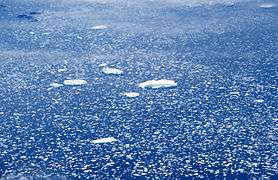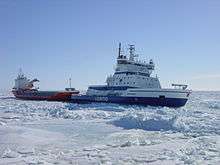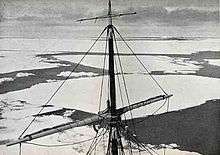Drift ice


Drift ice is any sea ice other than fast ice, the latter being attached ("fastened") to the shoreline or other fixed objects (shoals, grounded icebergs, etc.).[1][2][3] Drift ice is carried along by winds and sea currents, hence its name. When drift ice is driven together into a large single mass (>70% coverage), it is called pack ice.[1] Wind and currents can pile up that ice to form ridges up to several metres in height. These represent a challenge for icebreakers and offshore structures operating in cold oceans and seas.
Drift ice consists of floes, individual pieces of sea ice 20 metres (66 ft) or more across. There are names for various floe sizes: small – 20 metres (66 ft) to 100 metres (330 ft); medium – 100 metres (330 ft) to 500 metres (1,600 ft); big – 500 metres (1,600 ft) to 2,000 metres (6,600 ft); vast – 2 kilometres (1.2 mi) to 10 kilometres (6.2 mi); and giant – more than 10 kilometres (6.2 mi).[4][5]
Seasonal ice drift in the Sea of Okhotsk by the northern coast of Hokkaidō, Japan has become a tourist attraction of this area with harsh climate,[6] and is one of the 100 Soundscapes of Japan. The Sea of Okhotsk is the southernmost area in the Northern hemisphere where drift ice may be observed.[7]
Drift ice affects:
- Security of navigation
- Climatic impact (see Polar ice packs)
- Geological impact
- Biosphere influence (see Ecology of sea ice)
The two major ice packs are the Arctic ice pack and the Antarctic ice pack. The most important areas of pack ice are the polar ice packs formed from seawater in the Earth's polar regions: the Arctic ice pack of the Arctic Ocean and the Antarctic ice pack of the Southern Ocean. Polar packs significantly change their size during seasonal changes of the year. Because of vast amounts of water added to or removed from the oceans and atmosphere, the behavior of polar ice packs has a significant impact on global changes in climate.
 Icebreaker Kontio assisting merchant vessel in pack ice in the northern Baltic sea. In this photo the Kontio has become stuck in drift ice while towing a cargo ship. |
 Ice floes / pack ice |
 |
See also
- Drifting ice station
- Iceberg
- Ice shove
- Lead (sea ice)
- Polynya
- Pressure ridge (ice)
- Seabed gouging by ice
- Sea ice
- Shelf ice
References
- 1 2 WMO Sea-Ice Nomenclature
- ↑ Weeks, Willy F. (2010). On Sea Ice. University of Alaska Press. p. 2. ISBN 978-1-60223-101-6.
- ↑ Leppäranta, M. 2011. The Drift of Sea Ice. Berlin: Springer-Verlag.
- ↑ NSIDC All About Sea Ice
- ↑ Environment Canada Ice Glossary
- ↑ "A Port's Ice Is Thinning, and So Is Its Tourist Trade", New York Times, March 14, 2006.
- ↑ Honda, Meiji, Koji Yamazaki, Hisashi Nakamura, Kensuke Takeuchi, 1999: Dynamic and Thermodynamic Characteristics of Atmospheric Response to Anomalous Sea-Ice Extent in the Sea of Okhotsk. J. Climate, 12, 3347–3358.
External links
| Wikimedia Commons has media related to Glaciology. |
- "Drift Ice as a Geologic Agent", video by US Geologic Survey
- "Ice in the Sea" : chapter from Nathaniel Bowditch's American Practical Navigator
- Cryosphere Today : Current Arctic sea ice conditions
- Data source for sea ice picture
- Marine Modeling and Analysis Branch
- Everything you ever wanted to know about sea ice but were afraid to ask
- Animation of the movement of sea ice, September 2003 through May 2004
- NSIDC Sea Ice Index
- Atlas of Antarctic Sea Ice Drift